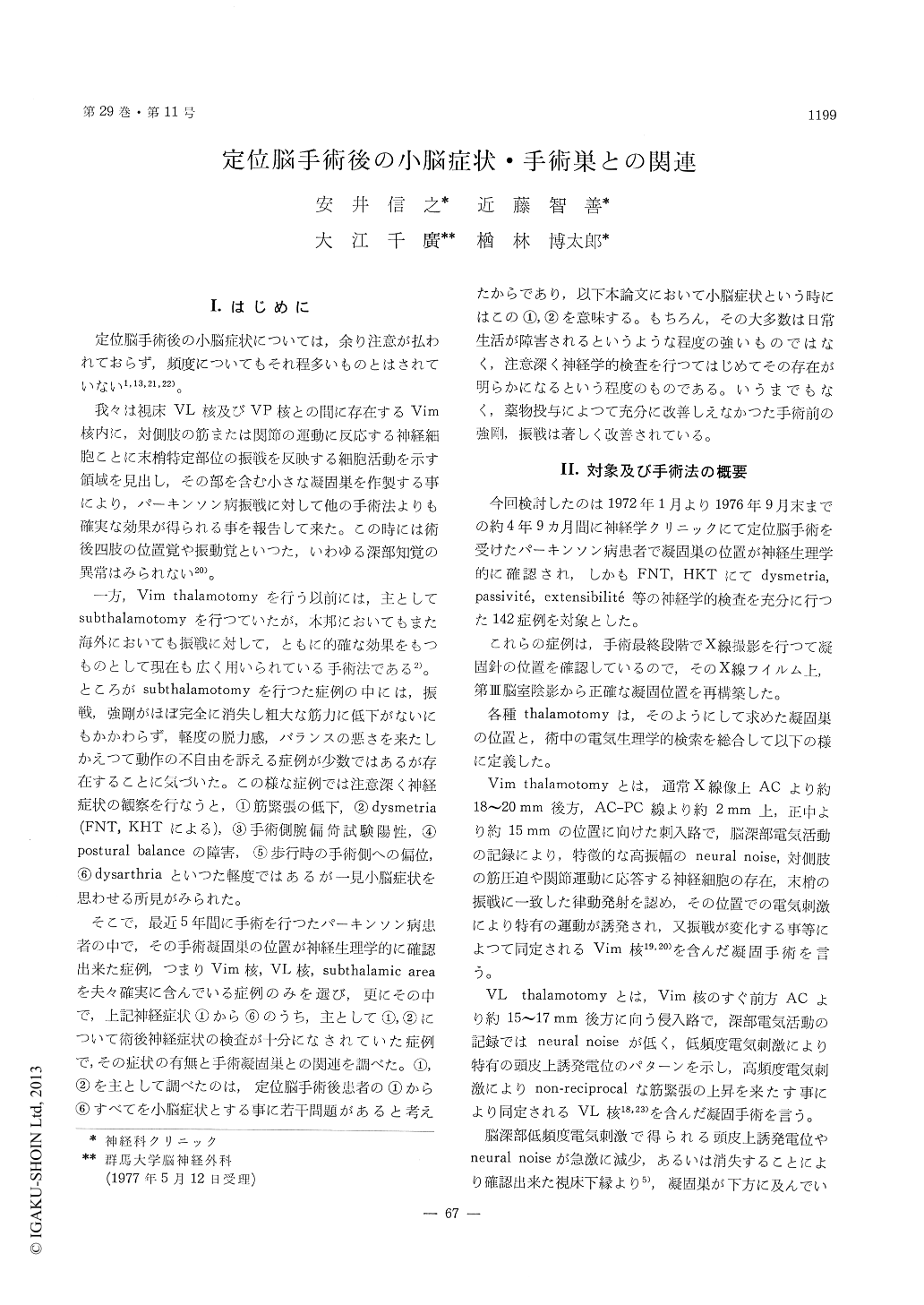Japanese
English
- 有料閲覧
- Abstract 文献概要
- 1ページ目 Look Inside
I.はじめに
定位脳手術後の小脳症状については,余り注意が払われておらず,頻度についてもそれ程多いものとはされていない1,13,21,22)。
我々は視床VL核及びVP核との間に存在するVim核内に,対側肢の筋または関節の運動に反応する神経細胞ことに末梢特定部位の振戦を反映する細胞活動を示す領域を見出し,その部を含む小さな凝固巣を作製する事により,パーキンソン病振戦に対して他の手術法よりも確実な効果が得られる事を報告して来た。この時には術後四肢の位置覚や振動覚といつた,いわゆる深部知覚の異常はみられない20)。
Stereotaxic lesions in the ventrolateral nucleus(VL) of thalamus and the sub-VL area have beenexperienced well to be effective for relief of tremorand rigidity of parkinsonism. Among these patientswho were treated successfully without producingany weakness or paresis, some patients still presentedpartial or slight cerebellar signs such as hypotonia,dysmetria, decomposition of movement, disturbanceof postural balance and gait, positive arm deviationtest and dysarthria. On the other hand, we havereported recently that physiological controlled Vim(ventralis intermedius nucleus) thalamotomy afterconfirming the tremor-synchronous cellular dis-charges is a most effective way for tremor allevi-ation without any neurological deficit.
In this paper, the results of correlative study onthe cerebellar signs and the site of thalamic orsubthalamic lesions in patients with Parkinson'sdisease are reported. Each stereotaxic lesion wasidentified in its exact location in the deep subcorticalstructures such as subthalamic area, VL thalamicnucleus and Vim thalamic nucleus by radiological,neurophysiological and neurological examinationsduring the course of surgery. As cerebellar signs,mainly hypotonia in passivite and extensibilitee anddysmetria in F-N test and H-K test were ex-amined.
The correlative analysis was done on recent 142cases of various thalamotomies in relation to cere-bellar signs thereby caused. Within two weeksafter operation, 40 cases of subthalamotomy, 16 casesof VL thalamotomy and 15 cases of Vim thalamo-tomy showed cerebellar signs. After two weeksor more, cerebellar signs persisted in 27 cases (40. 9%) of subthalamotomy, while in 9 cases (22.0%)of VL thalamotomy and in only 3 cases (8.6%) ofVim thalamotomy. This remarkable decrease inthe number of cases after two weeks in the groupof Vim thalamotomy may be due to recovery ofindirect effect of operative invasion. On the otherhand, relatively high incidence in cases of sub-thalamotomy would be a direct effect of surgicalinvasion, though the signs were usually slight andnot troublesome for patient's ADL.
The site of lesion was plotted referring to theintercommissural line and posterior commissure.Lesions in three kinds of thalamotomies weredivided into two groups depending on whether thepatients presented postoperative cerebellar signsmore than two weeks or not. In cases of Vimthalamotomy, there was no difference in locationof lesion between these two groups. In VL thalamo-tomy, lesions which caused cerebellar signs weremainly situated in the posterior part of this nucleusbut there was no difference in laterality. In sub-thalamotomy, there was clear difference in the siteof lesions between two groups. The more deeplyand posteriorly the lesions locate, the more thecerebellar signs.
Comparison of the operative effects of variousthalamotomies about two weeks after surgeryindicated no correlation between operative effectfor tremor and appearance of cerebellar signs.Ballism or other involuntary movement never ap-peared postoperatively.
It is suggested that subthalamotomy is not re-commendable because of its relatively high possi-bility of producing cerebellar signs, though practi-cally they are not serious at all. Secondarily, Vimthalamotomy can abolish tremor without any im-pairment and is experienced as the best device forrelief of tremor at present.

Copyright © 1977, Igaku-Shoin Ltd. All rights reserved.


